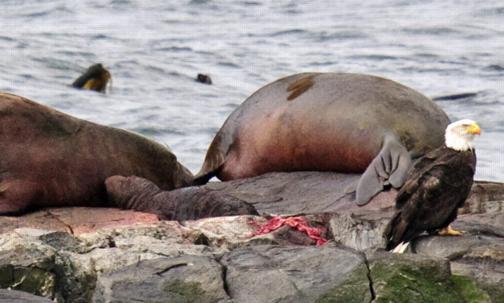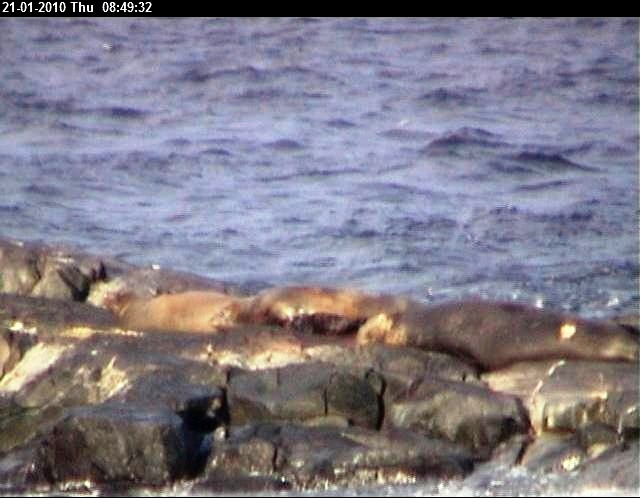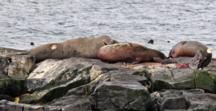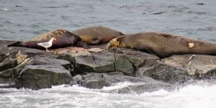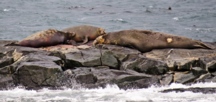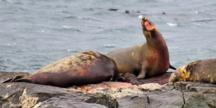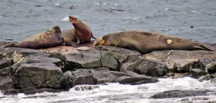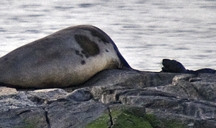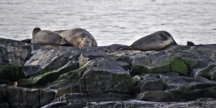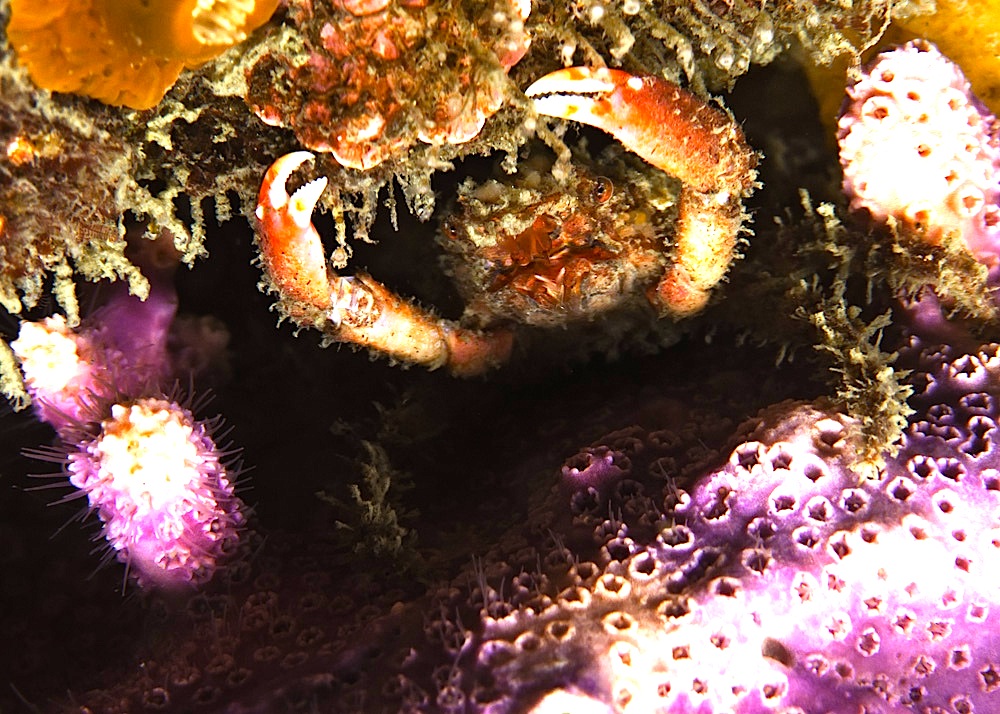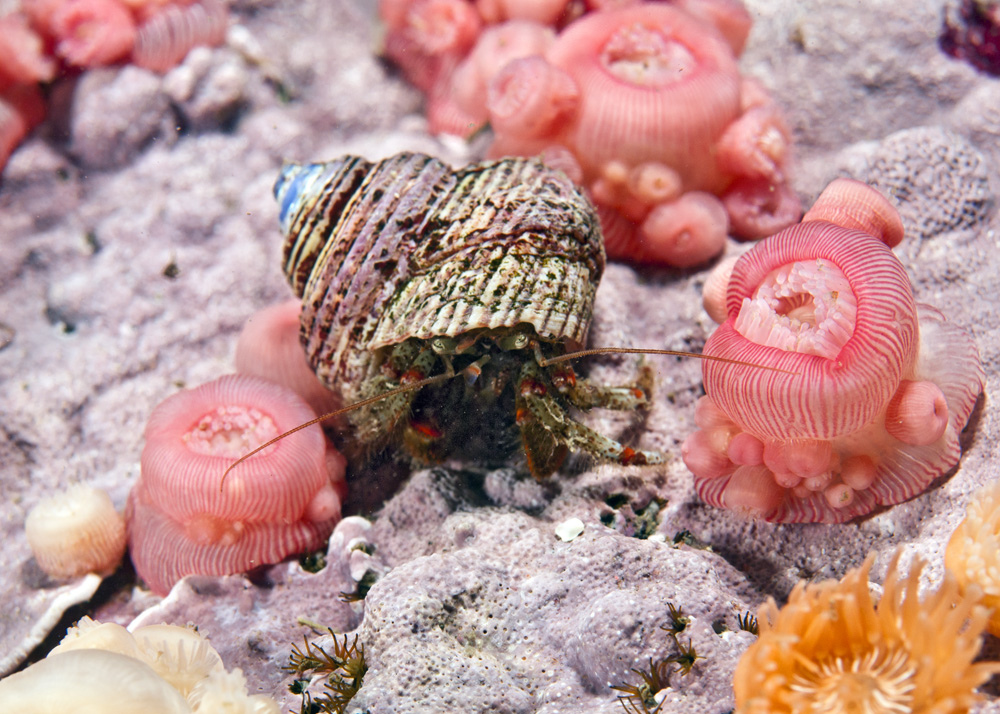‘2010-01-31’, ‘New pup heard over the sound of the boat at 100m… “Sounds like a frog ” -Jayesh -Year 35). Recognized the squawk as the pup vocalizing. Came through the West-Middle Rock channel -that is a popular and protected spot for local boat-based diving) and spotted the pup facing the three females -Scarlet and at least one of the two adults that landed on Great Race earlier in the year) but resting alongside Slash on the N side of the middle Middle Rock -out of sight of Camera 5). Beautiful day here, very nice and dry. Adult Bald eagle landed on the roof of the Science Centre, something I haven”t observed until now… probably Pam has lots of pics over the years; definitely a different season this time last year. Most of the ~40 Black oystercatchers -that had been on the south side of Great race in two large parcels around the Energy Centre this past week) have dispersed around the this part of the Strait of Juan de Fuca. They were the earliest of the bird activity this morning, sneaking around the exposed intertidal well before dawn. Looking South from the Main Keeper ”s residence is a flat calm with scattered driftwood armadas of Mew Gulls. Prince of Whales came through on an always-pleasant late day flood from the West as well. The ever-colourful character Misery is slouched across the concrete pathway to the Science Centre. The safest route now is across the exposed bedrock from the Energy Centre to the foundation of the old satellite dish and the steps on the SE corner of the building. Geese and gulls on the island are beginning to establish strutting and flutter room, pairs of Geese are acting territorially.’, ‘Ryan’, ’09:47:25 ,
Monthly Archives: January 2010
Seawater Temperature and Salinity Jan. 2010
We will be including our monthly submissions on daily seawater temperature and salinity as it is provided to IOS from the daily sampling by the Ecoguardians at Race Rocks.
See the PDF file:seawaterjan2010
Elephant seal pup on Middle Rock
Elephant seal gives birth on Middle Island
‘Elephant Seal’, 5, ‘Camera 5 user Pam Birley first spotted our FOURTH recorded elephant seal birth here at Race Rocks. The new pup is with two adult females and Slash on Middle Rocks and so far appears to be doing well. Its mother has been discouraging eagles, gulls, and black turnstones attracted to the afterbirth.’, ‘Ryan’, ’10:31:06 ,
Elephant Seal pup on Middle Rocks, 2010
Elephant Seal pup on Middle Rocks, January 21, 2010.
|
Wounded shoulder on Northern Sea lion
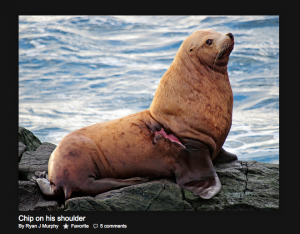 Injuries on the sea lions: Ryan recorded them with images on his Flickr site: A pretty nasty looking bite wound on this adult male. My first thought was it could have been an orca or shark, but looking at other images of similar bite wounds makes me think this was from another sea lion.
Injuries on the sea lions: Ryan recorded them with images on his Flickr site: A pretty nasty looking bite wound on this adult male. My first thought was it could have been an orca or shark, but looking at other images of similar bite wounds makes me think this was from another sea lion.
Northern Sea lions predominate
California Sea Lion’, 4, ‘Two adult males and 2 juvenile males are hauled out on the intertidal island on the SE corner of Great Race Island today. At least one adult male has been around this week.’, ‘Ryan’, ’12:19:52 ,
Northern Sea Lion’, 50, ‘Northern or Steller sea lion population has remained relatively constant this past month, with no major storms dispersing them for any amount of time. Interestingly, only 1 or 2 animals have ventured back to the largest of the Middle Rocks where the entangled sea lion was rescued. Instead, they have chosen to stay crowded on the smaller adjacent rock to the East.’, ‘Ryan’, ’12:21:57 ,
Slash and Misery conflicts
‘2010-01-17’, ‘Elephant Seal’, 4, ‘Both Slash and Misery have been hauled out on Great Race Island this past week. Misery prefers to take the higher ground to keep a strategic advantage against any of Slash ”s aggression. Misery has new bite wounds on his flank, though nothing like what Slash inflicted on him in the spring. Slash has a small cut on his nare and a small puncture wound on his hood/trunk. Pam Birley has captured and shared some photos on her flickr site which depict one of their territorial disputes in action! Both males trumpet -gurgle-burp) throughout the day, but most often at night. Neither male visibly responds to the other ”s calls. A small female has been seen frequently hauled out in the small cove formed by the gut on the South side of the island. She is much too small to mate or to climb from there up onto the rest of the island. Misery has been spending a lot of his time lounging around the Energy Centre, about 10m from the small female. Slash left here last night to join a large adult female on Middle Rock. I do not know if she is one of the three identifiable adult females who have visited Great Race Island this year, though she is the best candidate for another baby so far this season.’, ‘Ryan’, ’12:34:44 ,
Glebocarcinus oregonensis: Pygmy Rock Crab–The Race Rocks Taxonomy
Empty giant acorn shells are often the home for this small crab at Race Rocks. It was formerly called Cancer oregonensis
Scientific classification
Kingdom: Animalia
Phylum: Arthropoda
Subphylum: Crustacea
Class: Malacostraca
Order: Decapoda
Infraorder: Brachyura
Family: Cancridae
Genus: Glebocarcinus
Species: G. oregonensis
Other Members of the Phylum Arthropoda at Race Rocks.
and Image File |
 The Race Rocks taxonomy is a collaborative venture originally started with the Biology and Environmental Systems students of Lester Pearson College UWC. It now also has contributions added by Faculty, Staff, Volunteers and Observers on the remote control webcams. G. Fletcher The Race Rocks taxonomy is a collaborative venture originally started with the Biology and Environmental Systems students of Lester Pearson College UWC. It now also has contributions added by Faculty, Staff, Volunteers and Observers on the remote control webcams. G. Fletcher |
Pagurus beringanus: Bering hermit crab–The Race Rocks Taxonomy
This is a tentative identification of Pagurus Beringanus – the Bering Hermit Crab is an animal that is found from the Bering Sea to Monterrey, California. They are also found at Race Rocks. Commonly found at depths from intertidal to 365 meters.
This Pagurus is identifiable by their pale grey-blue shells (carapaces) mottled with grey, red and yellow spots. Legs are also pale blue with red bands at the joints. Claws are reddish and densely covered with spines. Bering Hermit Crabs all have characteristic green, irridescent eyes
Habitat – rocky, intertidal areas with cold water.
Behavior – Adults are inactive during the day. Starting late afternoon and carrying on through the night they become active and feed. This is because the retinal pigments in the eyes with position of the day and the night, only in response to the ambient light in the water.
Bering Hermit Crabs are scavengers, which makes the fact that they taste good puzzling. They eat dead plant materials and dead animal matter.
They themselves are prey to several types of fish, including pine perch, the California sheephead and the spotted kelpfish.
Females have been recorded with eggs mainly in April and May but some as early as February. During courtship, the male carries the female around for a day or more, knocking their shells together. The actual mating lasts less than a second, and both animals come almost completely out of their shells to perform the act.
References:
Intertidal Invertebrates of California. Morris, Abbot, Haderlie, 1980
Pacific Coast Crabs. Gregory C Jensen, 1995
Between Pacific Tides. Ricketts, Calvin, Hedgpeth, 1997
Classification:
Domain: Eukarya
Kingdom: Animalia
Phylum: Arthropoda
Class: Crustacea
Order: Decapoda
Superfamily: Paguridea
Family: Paguridea
Genus: Pagurus
Species: beringanus
Common Name: Bering Hermit Crab
Other Members of the Phylum Arthropoda at Race Rocks.
and Image File |
 The Race Rocks taxonomy is a collaborative venture originally started with the Biology and Environmental Systems students of Lester Pearson College UWC. It now also has contributions added by Faculty, Staff, Volunteers and Observers on the remote control webcams. The Race Rocks taxonomy is a collaborative venture originally started with the Biology and Environmental Systems students of Lester Pearson College UWC. It now also has contributions added by Faculty, Staff, Volunteers and Observers on the remote control webcams.Carmen Braden (PC yr 29) 2002 |


